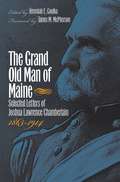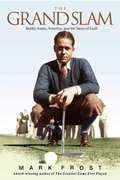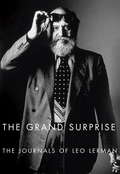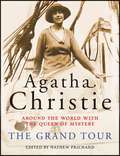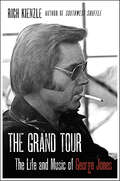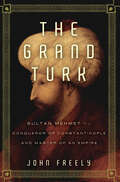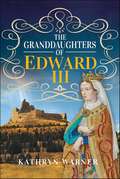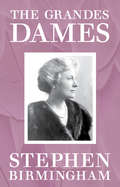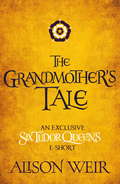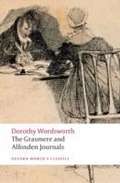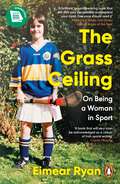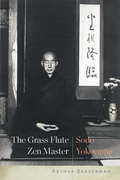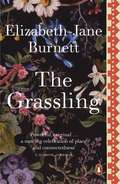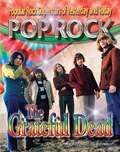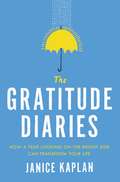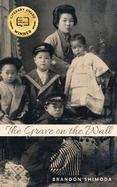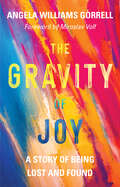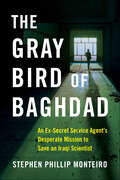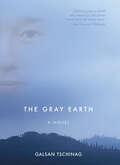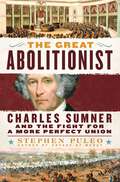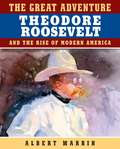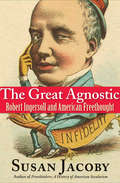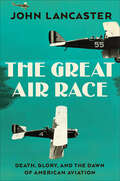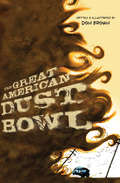- Table View
- List View
The Grand Old Man of Maine
by Jeremiah E. GoulkaBest known as the hero of Little Round Top at Gettysburg and the commanding officer of the troops who accepted the Confederates' surrender at Appomattox, Joshua Lawrence Chamberlain (1828-1914) has become one of the most famous and most studied figures of Civil War history. After the war, he went on to serve as governor of Maine and president of Bowdoin College. The first collection of his postwar letters, this book offers important insights for understanding Chamberlain's later years and his place in chronicling the war.The letters included here reveal Chamberlain's perspective on military events at Gettysburg, Five Forks, and Appomattox, and on the planning of ceremonies to celebrate the fiftieth anniversary of Gettysburg. As Jeremiah Goulka points out in his introduction, the letters also shed light on Chamberlain's views on politics, race relations, and education, and they expose some of the personal difficulties he faced late in life. On a broader scale, Chamberlain's correspondence contributes to a better understanding of the influence of Civil War veterans on American life and the impact of the war on veterans themselves. It also says much about state and national politics (including the politics of pensions), family roles and relationships, and ideas of masculinity in Victorian America.
The Grand Slam: Bobby Jones, America, and the Story of Golf
by Mark FrostFrom the bestselling author of the critically acclaimed The Greatest Game Ever Played comes The Grand Slam, a riveting, in-depth look at the life and times of golf icon Bobby Jones.In the wake of the stock market crash and the dawn of the Great Depression, a ray of light emerged from the world of sports in the summer of 1930. Bobby Jones, an amateur golfer who had already won nine of the seventeen major championships he'd entered during the last seven years, mounted his final campaign against the record books. In four months, he conquered the British Amateur Championship, the British Open, the United States Open, and finally the United States Amateur Championship, an achievement so extraordinary that writers dubbed it the Grand Slam.A natural, self-taught player, Jones made his debut at the U.S. Amateur Championship at the age of 14. But for the next seven years, Jones struggled in major championships, and not until he turned 21 in 1923 would he harness his immense talent.What the world didn't know was that throughout his playing career the intensely private Jones had longed to retreat from fame's glaring spotlight. While the press referred to him as "a golfing machine," the strain of competition exacted a ferocious toll on his physical and emotional well-being. During the season of the Slam he constantly battled exhaustion, nearly lost his life twice, and came perilously close to a total collapse. By the time he completed his unprecedented feat, Bobby Jones was the most famous man not only in golf, but in the history of American sports. Jones followed his crowning achievement with a shocking announcement: his retirement from the game at the age of 28. His abrupt disappearance from the public eye into a closely guarded private life helped create a mythological image of this hero from the Golden Age of sports that endures to this day.
The Grand Surprise: The Journals of Leo Lerman
by Leo LermanA remarkable life and a remarkable voice emerge from the journals, letters, and memoirs of Leo Lerman: writer, critic, editor at Condé Nast, and man about town at the center of New York's artistic and social circles from the 1940s until his death in 1994. Lerman's contributions to the world of the arts were large and varied: he wrote on theater, dance, music, art, books, and movies for publications as diverse as Mademoiselle and The New York Times. He was features editor at Vogue and editor in chief of Vanity Fair. He launched careers and trends, exposing the American public to new talents, fashions, and ideas. He was a legendary party host as well, counting Marlene Dietrich, Maria Callas, and Truman Capote among his intimates, and celebrities like Cary Grant, Jackie Onassis, Isak Dinesen, and Margot Fonteyn as part of his larger circle. But his personal accounts and correspondence reveal him also as having an unusually rich and complex private life, mourning the cultivated émigré world of 1930s and 1940s New York City, reflecting on being Jewish and an openly homosexual man, and intimately evoking his two most important lifelong relationships. From a man whose literary icon was Marcel Proust comes an unparalleled social and emotional history. With eloquence, insight, and wit, he filled his journals and letters with acute assessments, gossip, and priceless anecdotes while inimitably recording both our larger cultural history and his own moving private story.
The Grand Tour: Around the World with the Queen of Mystery
by Agatha ChristieAgatha Christie is the most widely published author of all time, outsold only by the Bible and Shakespeare. Now, in this fascinating travelogue of the prolific author's yearlong trip around the British Empire in 1922, Christie provides the clues to the origins of the plots and locales of some of her bestselling mystery novels. Containing never-before-published letters and photos from her travels, and filled with intriguing details about the exotic locations she visited, The Grand Tour is an important book for Agatha Christie fans, revealing an unexpected side to the world's most renowned mystery writer.
The Grand Tour: The Life and Music of George Jones
by Rich KienzleIn the vein of the classic Johnny Cash: The Life, this groundbreaking work explores the wild life and extraordinary musical career of “the definitive country singer of the last half century” (New York Times), who influenced, among others, Bob Dylan, Buck Owens, Emmylou Harris, John Fogerty, George Strait, Alan Jackson, and Garth Brooks.In a masterful biography laden with new revelations, veteran country music journalist/historian Rich Kienzle offers a definitive, full-bodied portrait of legendary country singer George Jones and the music that remains his legacy. Kienzle meticulously sifted through archival material, government records, recollections by colleagues and admirers, interviewing many involved in Jones’s life and career. The result: an evocative portrait of this enormously gifted, tragically tormented icon called “the Keith Richards of country.”Kienzle chronicles Jones’s impoverished East Texas childhood as the youngest son of a deeply religious mother and alcoholic, often-abusive father. He examines his three troubled marriages including his union with superstar Tammy Wynette and looks unsparingly at Jones’s demons. Alcohol and later cocaine nearly killed him until fourth wife Nancy helped him learn to love himself. Kienzle also details Jones’s remarkable musical journey from singing in violent Texas honky tonks to Grand Ole Opry star, hitmaker and master vocalist whose raw, emotionally powerful delivery remains the Gold Standard for country singers.The George Jones of this heartfelt biography lived hard before finding contentment until he died at eighty-one—a story filled with whiskey, women and drugs but always the saving grace of music.Illustrated with eight pages of photos.
The Grand Turk: Sultan Mehmet II-Conqueror of Constantinople and Master of an Empire
by John FreelyThe historian and author of Strolling Through Istanbul presents a detailed portrait of the fifteenth century Ottoman sultan, revealing the man behind the myths.Sultan Mehmet II—known to his countrymen as The Conqueror, and to much of Europe as The Terror of the World—was once Europe's most feared and powerful ruler. Now John Freely, the noted scholar of Turkish history, brings this charismatic hero to life in evocative and authoritative biography. Mehmet was barely twenty-one when he conquered Byzantine Constantinople, which became Istanbul and the capital of his mighty empire. He reigned for thirty years, during which time his armies extended the borders of his empire halfway across Asia Minor and as far into Europe as Hungary and Italy. Three popes called for crusades against him as Christian Europe came face to face with a new Muslim empire. Revered by the Turks and seen as a brutal tyrant by the West, Mehmet was a brilliant military leader as well as a renaissance prince. His court housed Persian and Turkish poets, Arab and Greek astronomers, and Italian scholars and artists. In The Grand Turk, Freely sheds vital new light on this enigmatic ruler.
The Granddaughters of Edward III
by Kathryn WarnerEdward III may be known for his restoration of English kingly authority after the disastrous and mysterious fall of his father, Edward II, and eventual demise of his mother, Queen Isabella. It was Edward III who arguably put England on the map as a military might. This show of power and strength was not simply through developments in government, success in warfare or the establishment of the Order of the Garter, which fused ideals of chivalry and national identity to form camaraderie between king and peerage. The expansion of England as a formidable European powerhouse was also achieved through the traditional lines of political marriages, particularly those of the king of England’s own granddaughters. This is a joint biography of nine of those women who lived between 1355 and 1440, and their dramatic, turbulent lives. One was queen of Portugal and was the mother of the Illustrious Generation; one married into the family of her parents' deadly enemies and became queen of Castile; one became pregnant by the king of England's half-brother while married to someone else, and her third husband was imprisoned for marrying her without permission; one was widowed at about 24 when her husband was summarily beheaded by a mob, and some years later bore an illegitimate daughter to an earl; one saw her marriage annulled so that her husband could marry a Bohemian lady-in-waiting; one was born illegitimate, had sixteen children, and was the grandmother of two kings of England.
The Grandes Dames
by Stephen BirminghamThe Grandes Dames gives brief and lively portraits of eight American women who wielded their wealth and influence to reshape the nation in the period between the 1870s and the Second World War.
The Grandes Dames
by Stephen BirminghamThe acclaimed social historian provides an in-depth look at eight society women who shaped upper class culture from the Gilded Age to WWII. Astor. Rockefeller. McCormick. Belmont. Family names that still adorn buildings, streets, and charity foundations. While their men blazed across America with their oil, industry, and railways, the matriarchs founded art museums, opera houses, and symphonies that functioned almost as private clubs. Linked by money, marriage, privilege, and power, these women formed a grand American matriarchy—and they ruled American society with a style and impact that make today&’s socialites seem pale reflections of their forbears. Stephen Birmingham takes us into the drawing rooms of these powerful women, providing keen insights into an American society that no longer exists. Caroline Astor, who, when asked for her fare boarding a streetcar, responded, &“No thank you, I have my own favorite charities.&” Edith &“Effie&” Stern deciding that no existing school would do for her child, so she had a new one built. And the legendary Isabella Stewart Gardner replying to a contemporary who was overly taken with their Mayflower ancestors: &“Of course, immigration laws are much more strict nowadays.&” These women had looks, manner, and style, but more than that, they had presence—a sense that when one of them entered a room, something momentous was about to occur; Birmingham opens a window to the highest levels of American society with these profiles of American &“royalty.&”
The Grandmother's Tale
by Alison WeirThe Grandmother's Tale by historian Alison Weir is an e-short and companion piece to Anne Boleyn: A King's Obsession, the second spellbinding novel in the Six Tudor Queens series.I see her from time to time, and I wish I didn't, but I don't say that. Nor do I tell my guests of my awful gift, or of how I kept seeing a sword over her head . . . Thomas once called me a witch. But witches practise their craft willingly. My visions come unbidden, and I have never been able to control them.As Anne Boleyn's grandmother mourns the death of her granddaughter, she also mourns the loss of Hever as she once knew it - filled with the joy and happiness of her family. With Anne's ghost still walking the halls, Margaret remembers her life in this grand house and the mysteries and rumours that line its walls. But with everything changed for ever, how long will Hever remain her home?Features the first chapter of Anne Boleyn: A King's Obsession and Jane Seymour: The Haunted Queen.SIX TUDOR QUEENS. SIX NOVELS. SIX YEARS.
The Grasmere and Alfoxden Journals
by Dorothy Wordsworth Pamela WoofDorothy Wordsworth's journals are a unique record of her life with her brother William, at the time when he was at the height of his poetic powers. Invaluable for the insight they give into the daily life of the poet and his friendship with Coleridge, they are also remarkable for their spontaneity and immediacy, and for the vivid descriptions of people, places, and incidents that inspired some of Wordsworth's best-loved poems. The Grasmere Journal was begun at Dove Cottage in May 1800 and kept for three years. Dorothy notes the walks and the weather, the friends, country neighbors and beggars on the roads; she sets down accounts of the garden, of Wordsworth's marriage, their concern for Coleridge, the composition of poetry. The earlier Alfoxden Journal was written during 1797-8, when the Wordsworths lived near Coleridge in Somerset. Not intended for publication, but to "give Wm Pleasure by it," both journals have a quality recognized by Wordsworth when he wrote of Dorothy that "she gave me eyes, she gave me ears."
The Grass Ceiling: On Being a Woman in Sport
by Eimear Ryan'A book which will very soon be acknowledged as a classic of Irish sportswriting' Ciarán MurphyWhat is it like to be female in a male-dominated sporting world? If you play with the boys, more people pay attention - but you get treated like an alien. Playing with other girls or women means you have to accept smaller audiences, diminished status and - for professionals - lower pay.And what if, as is the case for camogie player Eimear Ryan, your sport has a completely different name when women play it? What if you don't feel entirely comfortable in an all-female sporting environment because you're shy, bookish, not really one of the girls?In The Grass Ceiling, acclaimed novelist Eimear Ryan digs deep into the confluence of gender and sport, and all the questions it throws up about identity, status, competition and self-expression. At a time when women's sport is on the rise but still a long way from equality, it is a sharp, nuanced and heartfelt exploration of questions that affect everyone who loves sport.Praise for The Grass Ceiling'A gorgeous memoir about a life lived in sport, specifically a female, Irish rural life. I read it in two sittings.' Malachy Clerkin, Irish Times'A love letter to the GAA and a diatribe against the idea sport is not for women' Kathleen McNamee, Irish Times'Brilliant ... Ryan's bold and deep search into so many of those internalised questions provides a fascinating collage of emotional detail' Christy O'Connor, Irish Examiner 'Lyrical, urgent, wise and bracing' Irish Times
The Grass Flute Zen Master: Sodo Yokoyama
by Arthur BravermanWhat motivated Sodo–san to spend the last twenty years of his life in a “temple under the sky”— a corner of a public park where he taught passersby what it means to be forever young through the funky tunes he played on his grass flute? In The Grass Flute Zen Master: Sodo Yokoyama, we are seeking not only a truer understanding of this well–loved monk, but of zazen, Zen meditation, itself. In his search for insights into Sodo Yokoyama’s life, Arthur Braverman skillfully weaves a tapestry from seemingly disparate threads—the brief taisho period into which Sodo–san was born and where individualism shone; his teachers, both ancient and contemporary practitioners of Zen Bhuddism; the monk’s love of baseball; and the similarities Braverman finds between Sodo–san and Walt Whitman, who both found the universal in nature.Through conversations with Joko Shibata, Yokoyama’s sole disciple, and careful study of his teacher’s poetry, an intriguing tension between the personal and the universal is revealed. The Grass Flute Zen Master is a meditative examination not of just one life, but of many. The lineage of teacher and protégé is traced back through generations, contemporaries are drawn up from unexpected places, and Braverman examines his own long journey in Zen Buddhism; confronting his own expectations and surprising disappointments (the monk lived in a boarding house and later took a cab to his park when he could no longer walk the whole way) and the understanding and acceptance that followed. “When you play the leaf,” Sodo–san once wrote, “you’ll usually be a little out of tune. That’s where its very charm lies . . .”
The Grassling
by Elizabeth-Jane Burnett'A subtle, moving celebration of place and connectedness . . . The Grassling brings the sounds, smells and sights of the countryside alive like few other books. Burnett stretches the limits of prose, infusing it with poetic intensity to create a powerful, original voice' PD Smith, GuardianWhat fills my lungs is wider than breath could be. It is a place and a language torn, matted and melded; flowered and chiming with bones. That breath is that place and until I get there I will not really be breathing.Spurred on by her father's declining health and inspired by the history he once wrote of his small Devon village, Elizabeth-Jane Burnett delves through layers of memory, language and natural history to tell a powerful story of how the land shapes us and speaks to us. The Grassling is a book about roots: what it means to belong when the soil beneath our feet is constantly shifting, when the people and places that nurtured us are slipping away.
The Grateful Dead (Popular Rock Superstars of Yesterday and Today)
by Kenneth McintoshOver the course of thirty years, the Grateful Dead became America's most successful touring act, even performing in front of Egypt's great pyramids. In 1994, the Dead were inducted into the Rock and Roll Hall of Fame, and today, their music is still heard over the radio waves. Tribute bands help keep their sound alive, and the band's remaining members are still making music.
The Gratitude Diaries: How a Year Looking on the Bright Side Can Transform Your Life
by Janice KaplanIn this inspiring memoir backed by pioneering research, Janice Kaplan spends a year living gratefully and gains a fresh outlook that transforms her marriage, family life, work, health, and every day experience. On New Year's Eve, journalist and former Parade editor in chief Janice Kaplan makes a promise to be grateful and look on the bright side of whatever happens. She realizes that how she feels over the next months will have less to do with the events that occur than her own attitude and perspective. Getting advice at every turn from psychologists, academics, doctors, and philosophers she brings readers on a smart and witty journey to discover the value of appreciating what you have. Relying on both amusing personal experiences and extensive research, Kaplan explores how gratitude can transform every aspect of life including marriage and friendship, money and ambition, and health and fitness. She learns how appreciating your spouse changes the neurons of your brain and why saying thanks helps CEOs succeed. Through extensive interviews with experts and lively conversations with real people including celebrities like Matt Damon, Daniel Craig, and Jerry Seinfeld, Kaplan discovers the role of gratitude in everything from our sense of fulfillment to our children's happiness. With warmth, humor, and appealing insight, Janice's journey will empower readers to think positively and start living their own best year ever.
The Grave on the Wall
by Brandon ShimodaA memoir and book of mourning, a grandson's attempt to reconcile his own uncontested citizenship with his grandfather's lifelong struggle. Award-winning poet Brandon Shimoda has crafted a lyrical portrait of his paternal grandfather, Midori Shimoda, whose life--child migrant, talented photographer, suspected enemy alien and spy, desert wanderer, American citizen--mirrors the arc of Japanese America in the twentieth century. In a series of pilgrimages, Shimoda records the search to find his grandfather, and unfolds, in the process, a moving elegy on memory and forgetting.
The Gravity of Joy: A Story of Being Lost and Found
by Angela Williams Gorrell&“My vocation was supposed to be joy, and I was speaking at funerals.&” Shortly after being hired by Yale University to study joy, Angela Gorrell got word that a close family member had died by suicide. Less than a month later, she lost her father to a fatal opioid addiction and her nephew, only twenty-two years old, to sudden cardiac arrest. The theoretical joy she was researching at Yale suddenly felt shallow and distant—completely unattainable in the fog of grief she now found herself in. But joy was closer at hand than it seemed. As she began volunteering at a women&’s maximum-security prison, she met people who suffered extensively yet still showed a tremendous capacity for joy. Talking with these women, many of whom had struggled with addiction and suicidal thoughts themselves, she realized: &“Joy doesn&’t obliterate grief. . . . Instead, joy has a mysterious capacity to be felt alongside sorrow and even—sometimes most especially—in the midst of suffering.&” This is the story of Angela&’s discovery of an authentic, grounded Christian joy. But even more, it is an invitation for others to seize upon this more resilient joy as a counteragent to the twenty-first-century epidemics of despair, addiction, and suicide—a call to action for communities that yearn to find joy and are willing to &“walk together through the shadows&” to find it.
The Gray Bird of Baghdad: An Ex-Secret Service Agent's Desperate Mission to Save an Iraqi Scientist
by Stephen Phillip MonteiroA missing Iraqi scientist, an ex–Secret Service agent, and the threat of another biological terrorist attack—all these elements come together in the gripping true story of the Gray Bird of Baghdad. Iraqi Microbiologist Thamer Abdul Rahman Imran has information vital to stopping the unthinkable: a biological attack on the US. When he learns that the new Iraqi government wants to arrest him and the insurgents want to kill him, he goes into hiding. Racing against time, ex–Secret Service agent Steve Monteiro and his team set out on a mission to find the missing scientist and learn what he knows. The journey takes them from the White House to the Middle East as they fight bureaucrats in Washington who want them to fail. Why? And what is this vital information that Thamer possesses?The Gray Bird of Baghdad tells the true story of one’s man’s quest to protect his country and another man’s fight to save his family from the ravages of a country at war.
The Gray Earth: A Novel
by Galsan TschinagThe acclaimed Mongolian author of The Blue Sky continues his autobiographical trilogy as a young shepherd leaves his ancestral home for boarding school.This powerful, sweeping novel continues the saga of Dshurukawaa, the Tuvan shepherd boy introduced in The Blue Sky. Torn between the onset of visions and pressure from his family to attend a state boarding school, the adolescent attempts to mediate the pull of spirituality and pragmatism, old ways and new.Taken from his ancestral home, he reunites with his siblings at a boarding school, where his brother also serves as principal. Soon he comes to understand that the main purpose of the school is to strip the Tuvans of their language and traditions, and to make them conform to party ideals. When tragedy strikes, Dshurukawaa begins to sense the larger import of his visions, and with it a possible escape.Tschinag’s lyrical language, his striking characterizations, and his evocation of a singular way of life make The Gray Earth an unforgettable read and a worthy follow-up to The Blue Sky.
The Great Abolitionist: Charles Sumner and the Fight for a More Perfect Union
by Stephen PuleoThe groundbreaking biography of a forgotten civil rights hero.In the tempestuous mid-19th century, as slavery consumed Congressional debate and America careened toward civil war and split apart–when the very future of the nation hung in the balance–Charles Sumner’s voice rang strongest, bravest, and most unwavering. Where others preached compromise and moderation, he denounced slavery’s evils to all who would listen and demanded that it be wiped out of existence. More than any other person of his era, he blazed the trail on the country’s long, uneven, and ongoing journey toward realizing its full promise to become a more perfect union.Before and during the Civil War, at great personal sacrifice, Sumner was the conscience of the North and the most influential politician fighting for abolition. Throughout Reconstruction, no one championed the rights of emancipated people more than he did. Through the force of his words and his will, he moved America toward the twin goals of abolitionism and equal rights, which he fought for literally until the day he died. He laid the cornerstone arguments that civil rights advocates would build upon over the next century as the country strove to achieve equality among the races.The Great Abolitionist is the first major biography of Charles Sumner to be published in over 50 years. Acclaimed historian Stephen Puleo relates the story of one of the most influential political figures in American history with evocative and accessible prose, transporting readers back to an era when our leaders exhibited true courage and authenticity in the face of unprecedented challenges.
The Great Adventure: Theodore Roosevelt and the Rise of Modern America
by Albert MarrinWe knew toil and hardship and hunger and thirst ... but we felt the hardy life in our veins, and ours was the glory of work and the joy of living. -Theodore Roosevelt. Theodore Roosevelt is one of America's liveliest and most influential figures. He was a scholar, cowboy, war hero, explorer, and a brilliant politician. As president, Roosevelt's far-reaching policies abroad and at home forever changed both our nation's place in the world and the life of every modern American. Fascinating details and an intimate, fast-paced narrative explore the heroic life and complex world of an American icon.
The Great Agnostic: Robert Ingersoll and American Freethought
by Susan Jacoby&“Jacoby writes with wit and vigor, affectionately resurrecting a man whose life and work are due for reconsideration&” (The Boston Globe). During the Gilded Age, which saw the dawn of America&’s enduring culture wars, Robert Green Ingersoll was known as &“the Great Agnostic.&” The nation&’s most famous orator, he raised his voice on behalf of Enlightenment reason, secularism, and the separation of church and state with a power unmatched since America&’s revolutionary generation. When he died in 1899, even his religious enemies acknowledged that he might have aspired to the US presidency had he been willing to mask his opposition to religion. To the question that retains its controversial power today—was the United States founded as a Christian nation?—Ingersoll answered an emphatic no. In this provocative biography, Susan Jacoby, author of Freethinkers: A History of American Secularism, restores Ingersoll to his rightful place in an American intellectual tradition extending from Thomas Jefferson and Thomas Paine to the current generation of &“new atheists.&” Jacoby illuminates the ways in which America&’s often-denigrated and forgotten secular history encompasses issues, ranging from women&’s rights to evolution, as potent and divisive today as they were in Ingersoll&’s time. Ingersoll emerges in this portrait as an indispensable public figure who devoted his life to that greatest secular idea of all—liberty of conscience belonging to the religious and nonreligious alike. &“Jacoby&’s goal of elucidating the life and work of Robert Ingersoll is admirably accomplished. She offers a host of well-chosen quotations from his work, and she deftly displays the effect he had on others. For instance: after a young Eugene V. Debs heard Ingersoll talk, Debs accompanied him to the train station and then—just so he could continue the conversation—bought himself a ticket and rode all the way from Terre Haute to Cincinnati. Readers today may well find Ingersoll&’s company equally entrancing.&” —Jennifer Michael Hecht, The New York Times Book Review
The Great Air Race: Glory, Tragedy, And The Dawn Of American Aviation
by John LancasterThe incredible, untold story of the men who risked their lives in the first transcontinental air contest—and put American aviation on the map. The Great Air Race reclaims one of the most important moments in the history of American aviation: the transcontinental air race of October 1919 that saw scores of pilots compete for the fastest roundtrip time between New York and San Francisco in frail, open-cockpit biplanes. Riveting the nation, the aviators—most of them veterans of the Great War—pioneered the first coast-to-coast air route, braving blizzards and driving rain as they landed in fields or at the edges of cliffs. Bringing the pilots and the race’s impresario, Billy Mitchell, to vivid life, journalist and amateur pilot John Lancaster captures the challenges of flying in that almost prehistoric age—the deafening roar of the engine, the constant fear of mechanical failure, the threat posed by mere rain. As he demonstrates, the race, despite much drama and tragedy, was a milestone in the development of commercial aviation. The Great Air Race is a captivating story of man and machine, and the debut of a major new popular historian.
The Great American Dust Bowl
by Don BrownA speck of dust is a tiny thing. In fact, five of them could fit into the period at the end of this sentence.On a clear, warm Sunday, April 14, 1935, a wild wind whipped up millions upon millions of these specks of dust to form a duster—a savage storm—on America's high southern plains. The sky turned black, sand-filled winds scoured the paint off houses and cars, trains derailed, and electricity coursed through the air. Sand and dirt fell like snow—people got lost in the gloom and suffocated . . . and that was just the beginning.Don Brown brings the Dirty Thirties to life with kinetic, highly saturated, and lively artwork in this graphic novel of one of America's most catastrophic natural events: the Dust Bowl.
